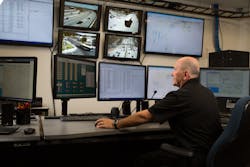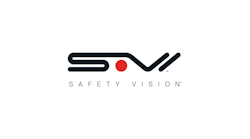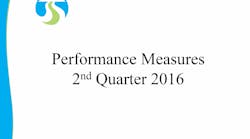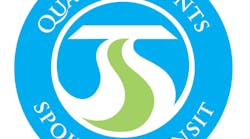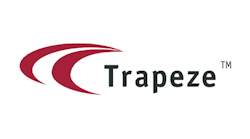By time this issue goes to press, November 8 will have come and gone and many regions across the United States will have voted on transportation ballot measures, including Spokane, Washington, where Proposition 1 would authorize an increase in local sales and use tax of up to 0.2 percent to help maintain, improve and expand public transit.
Spokane Transit Authority (STA) has gone through a lot of changes since the last ballot measure was passed in 2004, including bringing on E. Susan Meyer as chief executive officer in 2005.
What makes this year’s ballot measure different from previous measures, is it’s the first time there is a plan to grow transit in the communities STA serves, where as in times past it was to replace funding that had been lost.
The state had been providing about half of STA’s funding through the state motor vehicle excise tax. After that was eliminated, STA went to ballot to increase its tax authority in 2002 but lost.
In 2004 they went back to the voters and it was approved. Since that time they’ve had the opportunity to prove itself to the community. They have 11 years of clean audits from the auditor in the state of Washington and they can show how they’ve become good financial stewards.
When the board hired Meyer, they were looking for someone with a business background and a focus on customer service. Meyer’s previous job had been with a global telecommunications manufacturer as vice president of human resources in corporate relations.
When she came onboard, Meyer said the chime at the time by a leader in the community was, “Hold your nose and vote yes,” regarding the 2004 ballot. “That is how badly the organization had ruined its credibility,” she explained. But the board had established priorities and when she came to the interview, she wanted to continue the evolution of what they had started.
After the initial ballot measure was passed, STA delivered everything the organization had promised a year early and STA went back to the ballot to get the three-tenths of a cent extended permanently and it was approved by more than 65 percent by the voters in 2008.
Plaza Renovation
Meyer admitted that even she had perceptions about the agency at the time she came onboard, some of which weren’t accurate.
“One was that the bus drivers were over paid, the other was that there was too much administration and the third one was that we built the downtown transit center in the wrong place,” she said.
“When I got here I was surprised to learn that we have competitive wages but our people aren’t over paid and we didn’t have enough administrative infrastructure to accomplish all the things we wanted to accomplish …” She continued, “I do think the plaza was not built in the right place but you know what? We own it, it operates really well and we have lots of conversations on an ongoing basis with our business friends whose buildings surround our downtown transit center.”
The STA Plaza renovation is part of a long-term commitment to improve operations downtown. The original plan for the building in ’94 was for it to be an indoor atrium with soaring ceilings and skylights – not much functional space.
Through the renovation, they are making the space more efficient. They are bringing all of the patron-related services to the first floor. Customer service, restrooms and retail was all on the second floor, so if you’re on the main floor to catch a bus, you would have to go upstairs to ask a question. While it was intended to drive business to the retail businesses upstairs, Meyer said they concluded it was a failed strategy and having food, restrooms and customer service on the first floor is making better use of the space.
As part of Phase 1, security offices were moved to the second floor and Phase 2 includes significant construction on the first floor. It’s scheduled to be done mid-next year and Meyer said they are right on schedule.
Image Basics
STA has focused on being transparent, being accountable and being good stewards of public funds. One example Meyer cited was during the recession, STA strategically reduced service 10 percent over two years’ time to live within its means.
With a solid background in business, Meyer wanted to bring in transit expertise to assess the situation. She said she had the American Public Transportation Association (APTA) come to do a peer review in 2007. There was APTA staff and two transit CEOs that came and spent three days at STA. “We aired our laundry and then committed to making things better,” she said.
While they thought they were being good financial stewards by running buses longer than most would, they learned they were keeping them longer than they should have been. Buses didn’t look great, didn’t operate great and the peer review panel said if STA’s largest financial asset doesn’t look good, doesn’t operate good, people will see that on the street and make a judgement.
STA was also deep cleaning buses only every five months, because that was the level of staff available. “We thought we were doing a good job,” Meyer said.
Now they’re deep cleaning buses every 10 week and have changed the fleet replacement plan to maximize their investments in those buses.
Quality Counts
There were a lot of things learned from the peer review experience and the input was the foundation of an effort STA launched called ‘Quality Counts.”
One of the ongoing efforts of Quality Counts is a mystery shopper program that looks to reward excellence – there’s nothing punitive about the program. There are two questions: Was it an excellent experience, which has certain criteria, and then a was your overall experience with the STA employee professional and courteous and they are graded on a scale of 1 to 5.
STA defined excellence for each work group within the organization and everyone within the organization gets shopped. “The first time I got shopped I got an excellent; I put the pin on my lapel. And then the next time I got shopped, I did not,” Meyer said.
“We have all of these people out on the road and I can’t see them when they’re doing a great job,” said Meyer. “This is a way for us to confirm that we’re doing a great job and the board of directors love this because if you say excellent customer service is your highest priority and you have no way to measure it, those are just words.”
She said at first there were concerns with starting a new program, particularly with the unions being concerned that the mystery shoppers would be to catch drivers doing something wrong. At one time they did have a program like that, “spotters” would catch operators catching a short fare or not getting close enough to the curb. The shoppers aren’t there to give a professional perspective how the bus operator — or any other staff member — is doing at the particular job, they’re there to give the customer experience.
Each department has different criteria to measure excellence:
- Administration & Staff
- Fixed Route
- Paratransit
- Customer Service
- Reservations
- Security
Bringing Technology On Board
In addition to deferring bus purchases, Meyer said they were deferring technology for years to keep service on the road, as well.
“We decided that we were going to be asset stewards and so we started the Smart Bus Project,” she explained. It has multiple elements and the first one was cameras on vehicles. They have Safety Vision cameras and software and it has been enormously helpful when it comes to complaints and allegations of responsibility.
While drivers were initially concerned about cameras on the vehicles, so STA established a memorandum of understanding that describes how the videos would be used for discipline if necessary. Each month there is a report of how many videos were pulled based on complaints and how many of them were substantiated.
Meyer said it also means they don’t have to tell an operator when there’s been a complaint before it’s been substantiated by the video and that then decreases the stress level of operators.
The cameras also improve the safety and security on the system and in the community it serves. A couple of years ago, a man that had gone through the downtown center had murdered someone. Though it didn’t happen at the plaza, police shut it down and went to the security office view video. They were able to see which direction he went, identify the bus that was at the curb in the zone when the man let the plaza and then view the video from the bus.
STA Communications Specialist Brandon Rapez-Betty said, “The quality of the camera captured the images of the tattoo [on his arm].”
Long story short, he confessed and was put in jail.
While the cameras have brought great benefit, the capstone of the technology, Meyer said, was the CAD/AVL. “It’s a wonderful thing,” Meyer said. Before they bought the software, they talked to other transit agencies to see how they used it.
They have Trapeze software in place and they’re at the very end of doing beta testing on the passenger information, real-time departure information. She said, “We’re kind of cautious about introducing before we did a lengthy beta test, but it’s working really well.
“We had a hiccup where we were having some troubles with the system picking up detours, but I think we have overcome that. Any technology project is incredibly detailed-driven and the devil and the angel are in the details. It was a really well-thought-out process for getting it, installing it and learning it to make maximize it for our customers.”
Rapez-Betty added, “We’re about to release the real-time data information to Google so it will adhere to the Google platform.
Measuring Results
The American Bus Benchmarking Group through the Empirical College of London has helped STA in learning from its peers and improving its business. They are one of about 20 transit agencies in this benchmarking group who all sign agreements of confidentiality to not share information of what others are reporting.
“This has been a really good way of standardizing what we measure and how we measure it,” said Meyer. “You could look at these agencies and say these are all already high-performing agencies but we all want to get better.”
Meyer explained their quarterly performance metrics that are set annually and approved by the board. Each of STA’s organizational priorities are tied to a set of measures that say what people want to know, she said.
“I think everybody responds to learning that a government agency is well run but the business community needs things translated for them and that is what this does,” she explained. “When I go to the state capitol to brief our elected officials about what we’re doing and how we’re doing it, the response to our performance measures is just amazing. And, we get the same kind of reaction in Washington, D.C.”
Paratransit Savings
Focusing on excellent customer service was part of the equation, improving performance metrics to greater efficiencies was another major part of improvements. One area of improved efficiency is for their lower paratransit cost per trip, which is at about $25.
STA began doing in-person assessments on about half their applications and all of the recertifications. They found they had been granting full eligibility to some folks who really only qualified for provisional eligibility.
At the downtown plaza STA has a mobility training center where people have assessments and can get travel training. “Almost everybody likes the independence that a bus provides, rather than a shared ride,” said Meyer. “We get lots of folks who like to use the bus and they thought they wanted to use paratransit.”
They contract out about half the service to MV Transportation and hold the contractor to the same criteria as its own employees, including doing mystery shopping on the contracted employees, as well.
Another way STA has been able to take some of the load off of its paratransit service is through the van grant program. STA grants 10 vans a year that are about to go out of service to organizations that transport people that would be using paratransit instead. Meyer said it took a while to get it worked out so they could do it without it being a gift of public funds, but they’ve been glad the program’s worked out so well.
